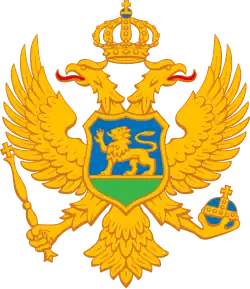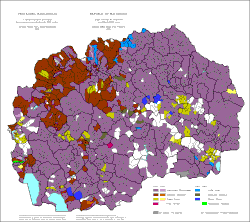Montenegrins of North Macedonia
| Total population | |
|---|---|
| 1,023 | |
| Languages | |
| Macedonian, Montenegrn | |
| Religion | |
| Eastern Orthodoxy, Islam | |
| Related ethnic groups | |
| Montenegrins |
Montenegrins form an ethnic minority in North Macedonia. In the 2021 census, there were 1,023 declared Montenegrins. Today, the majority of Montenegrins primarily speak Macedonian.[1]: 14 In 2010, it was estimated that around 10,000 Macedonians have Montenegrin ancestry, and 253 Montenegrins lived in Ohrid.[2]
History
The first significant immigration of Montenegrins to Macedonia started soon after the creation of the Kingdom of Serbs, Croats, and Slovenes, with the process of the colonization of the Vardar Banovina (25 September 1920 Settlement Decree), where they received land in Debelo Polje. The main centers were near the Greek border, around the towns of Gevgelija, Dojran, Kavadarci, Resen, Bitola, and Ohrid. Today, there are around 250 descendants of this wave living in Ohrid. The second period occurred after the end of the Second World War, in 1955-56, during a wave of emigration of Muslims from Yugoslavia to Turkey. This was caused by the 1953 informal agreement between Yugoslavia and Turkey to expedite the emigration of Yugoslav Turks, especially those who had relatives in Turkey. In SR Macedonia, the process was initiated through the Turkish Consulate in Skopje. However, many non-Turkish Muslims in Yugoslavia passed through the process because of documentary issues, especially for applicants outside the state, administrative apathy, and the liberal approach of Turkish immigration policy. However, after the closure of the border in 1956- when the Consulate started to strictly permit only Macedonian Turks- some Montenegrins remained in Prilep, Dolneni, Lažani, Veles, and Skopje. Finally, the third period started after the 1963 Skopje earthquake, primarily from northern Montenegro. They settled in enclaves around the city: Ljubin, Donje Konjare, and Gornje Konjare. One part of this community has since moved to Skopje, and another part emigrated to western Europe. Besides this, intermittent naturalization of officers, civil servants, and others, upon the completion of their education, occurred.[1]: 3 [3][4][5]
In 2006, the organization Community of Montenegrins in RN Macedonia was founded.[6][7]
Demographics
| Year | Pop. | ±% |
|---|---|---|
| 1948 | 2,348 | — |
| 1953 | 2,526 | +7.6% |
| 1961 | 3,414 | +35.2% |
| 1971 | 3,246 | −4.9% |
| 1981 | 3,940 | +21.4% |
| 1991 | 3,225 | −18.1% |
| 1994 | 2,318 | −28.1% |
| 2002 | 2,003 | −13.6% |
| 2021 | 1,023 | −48.9% |
| Source: [8][9] | ||
See also
- Montenegro–North Macedonia relations
- Montenegrin diaspora
- Ethnic groups in North Macedonia
- Macedonians in Montenegro
References
- ^ a b Orlandić, Miroljub; Gjoševska, Evgenija; Spasić, Sara (March 2021). Crnogorski iseljenici u Sjevernoj Makedoniji [Montenegrin Emigrants in North Macedonia] (PDF) (in Montenegrin). Skopje: Istraživački centar Montenegrin.
- ^ Jovanoski, Milčo (21 December 2010). Aceska, Žana (ed.). "Мајка-Македонија, татко-Црна Гора". Deutsche Welle.
- ^ Rakočević, Bogić (Summer–Fall 2011). "Crnogorci u Ohridu" [Montenegrins in Ohrid]. Matica (in Montenegrin) (46/47). Matica Crnogorska: 197–198.
- ^ Kirović, Vera. "Crnogorski iseljenici u Makedoniji". Asocijacija dijaspore Crne Gore.
- ^ Pezo, Edvin (2013). "Komparativna analiza jugoslovensko-turske konvencije iz 1938. i "džentlmenskog sporazuma" iz 1953. - Pregovori oko iseljavanja muslimana iz Jugoslavije u Tursku" (PDF). Tokovi Istorije (2/2013): 117–19.
- ^ "Црногорците во Македонија формираа заедница". Dnevnik Online. 22 October 2016. Archived from the original on 24 July 2012.
- ^ "Klubovi i udruženja u Republici Makedoniji". Crnogorska zajednica u Republici Makedoniji.
- ^ "Dabase". Archived from the original on 2011-03-09. Retrieved 2011-02-24.
- ^ "Census of Population, Households and Dwellings in the Republic of North Macedonia, 2021 - first dataset".

